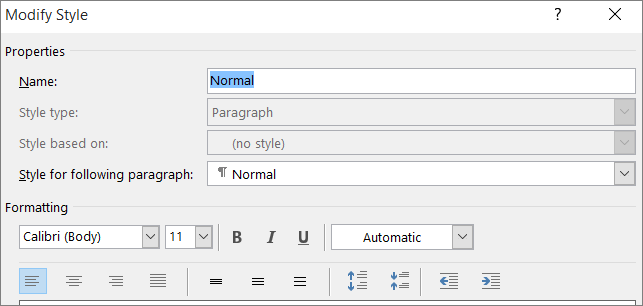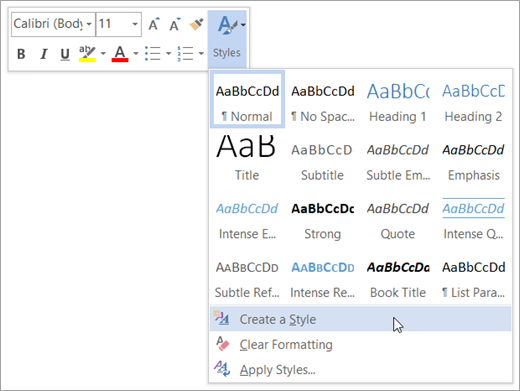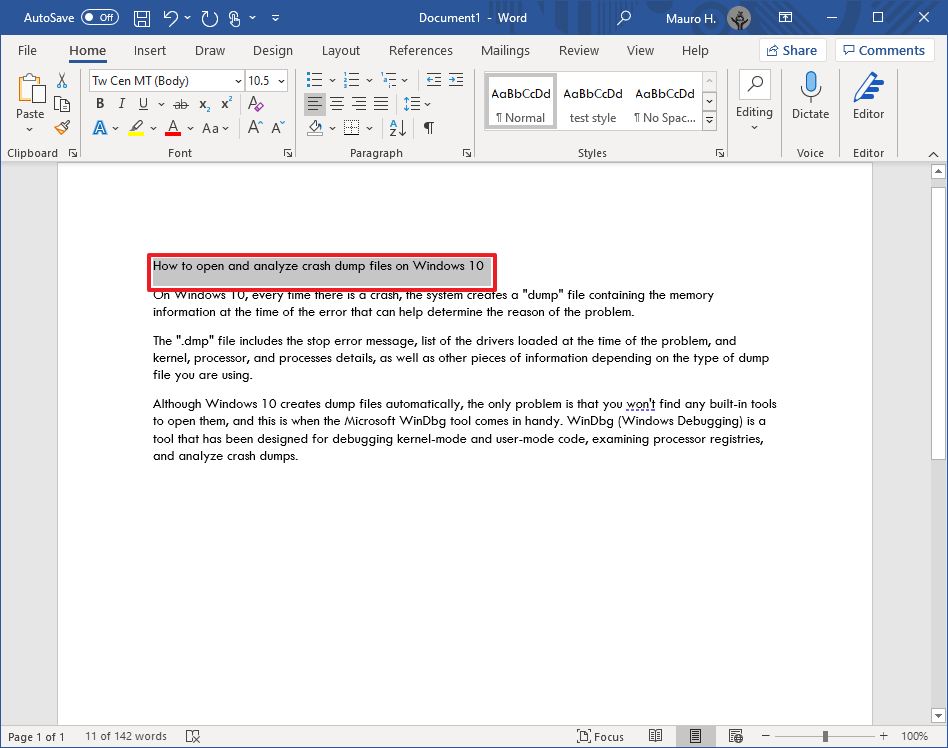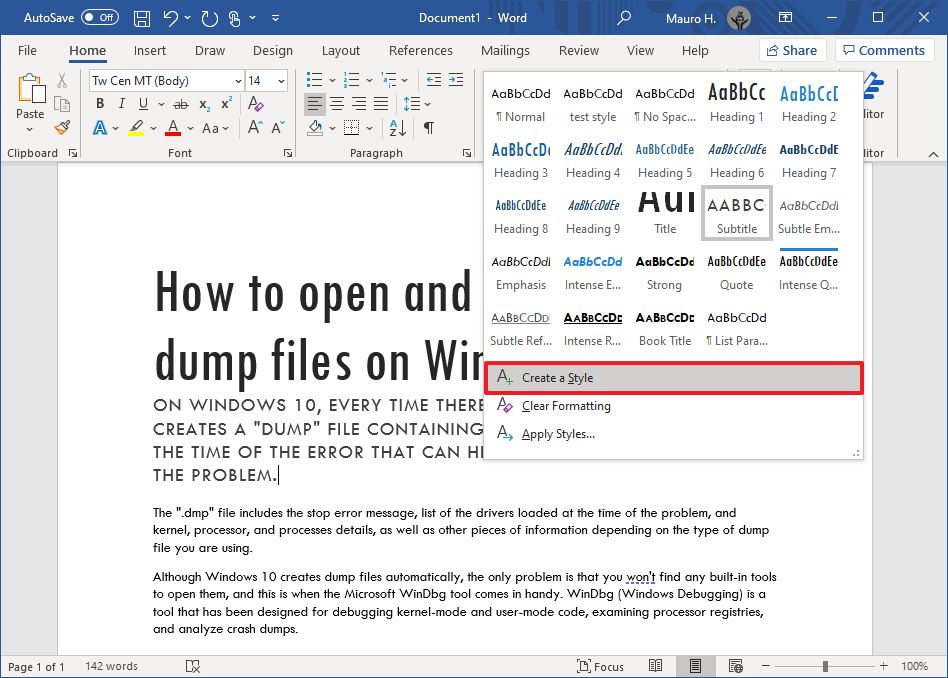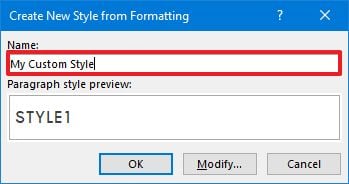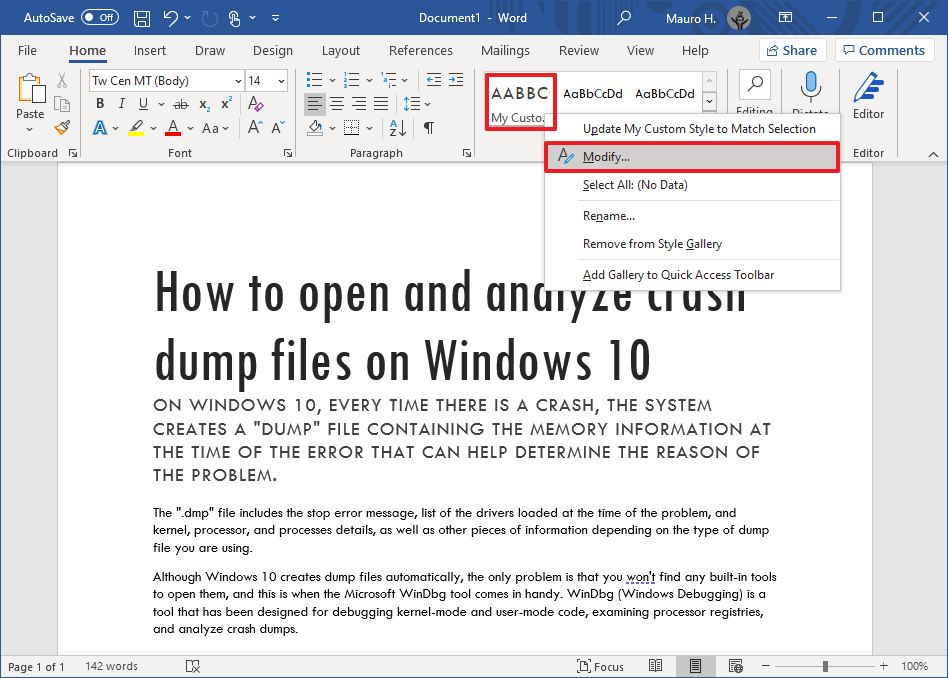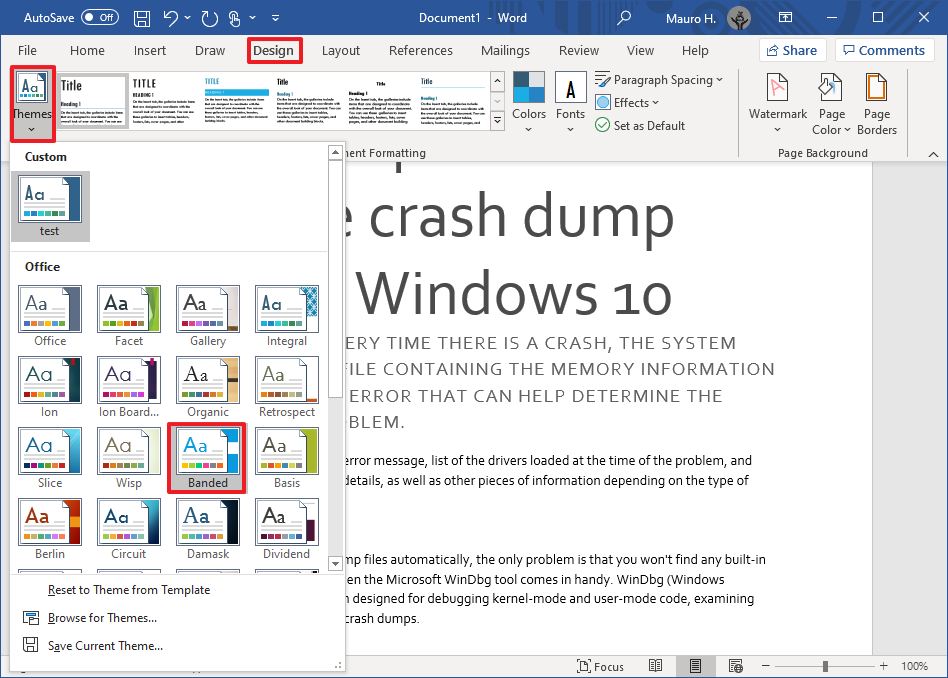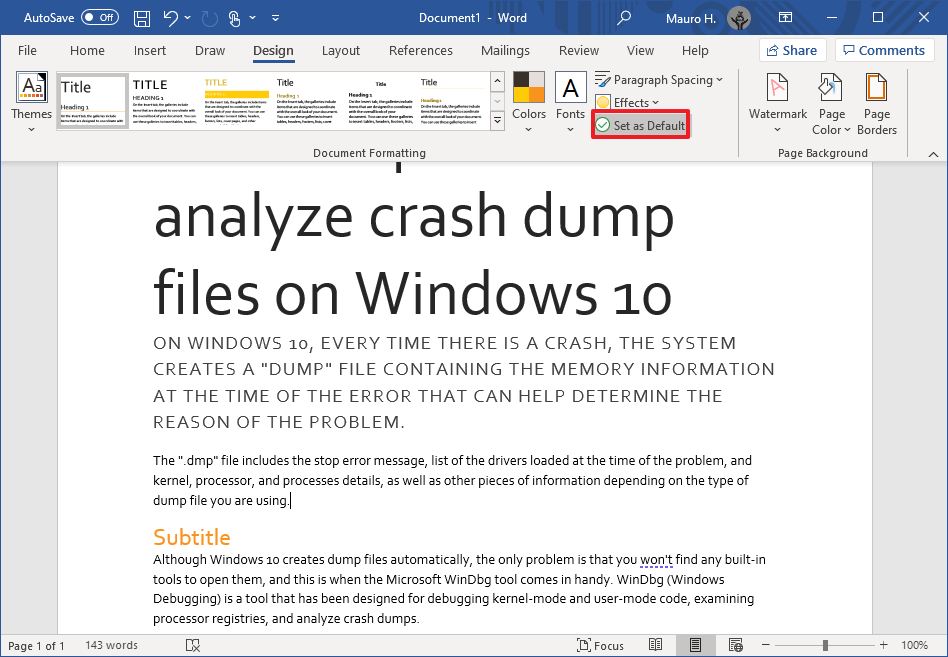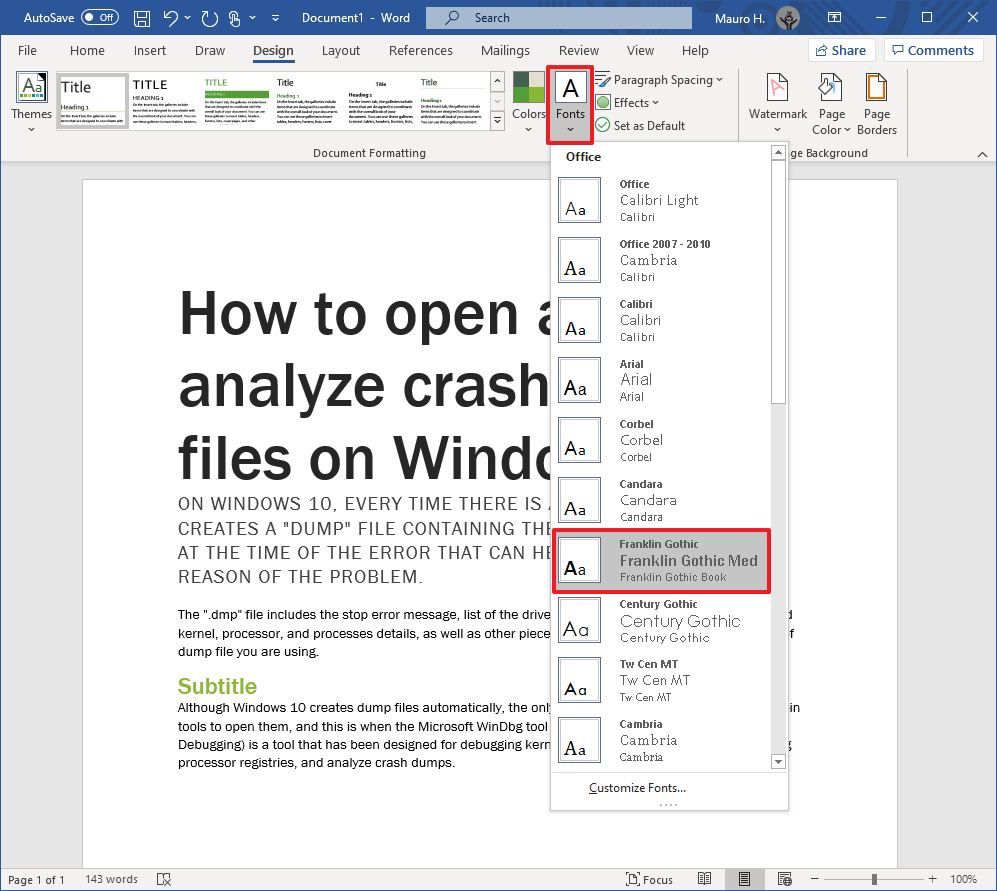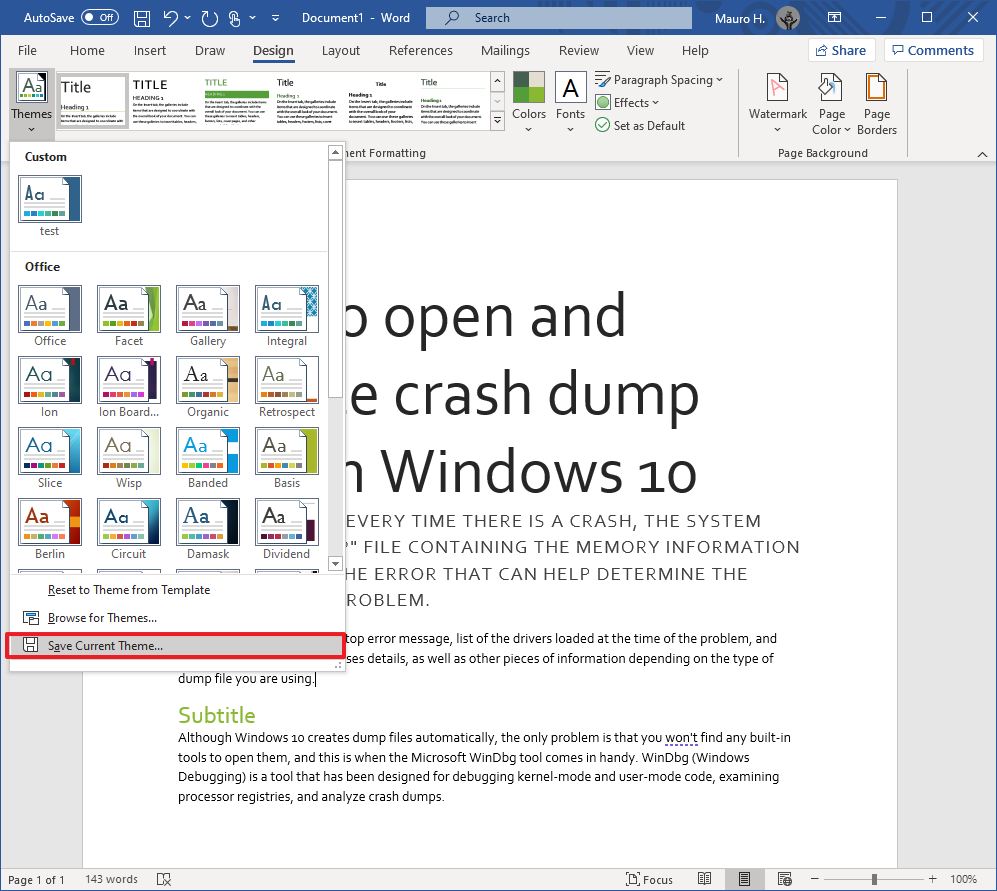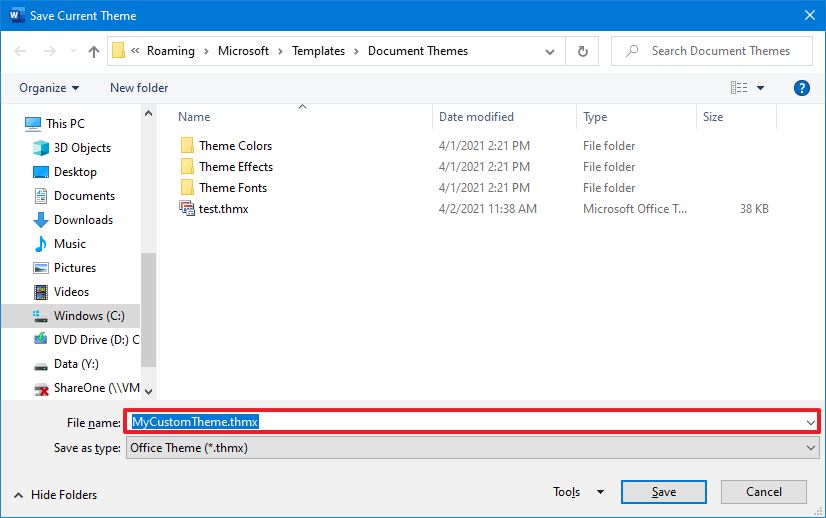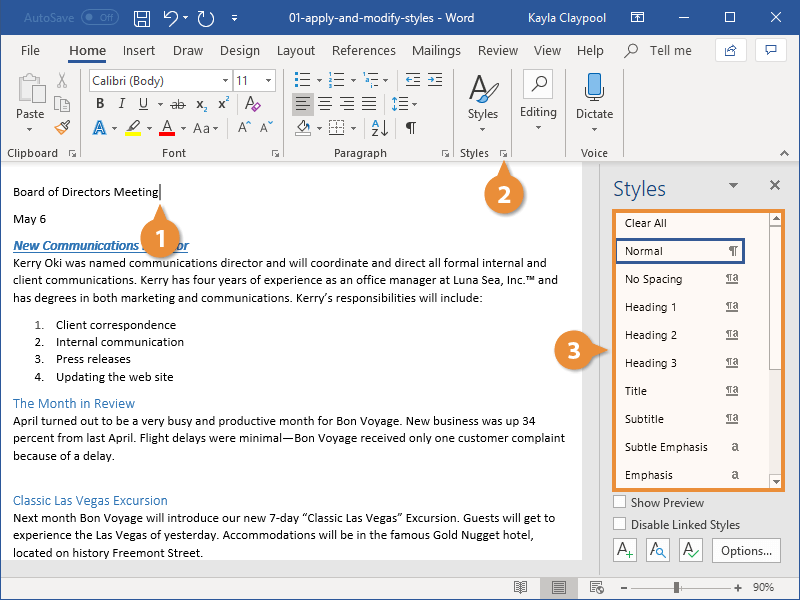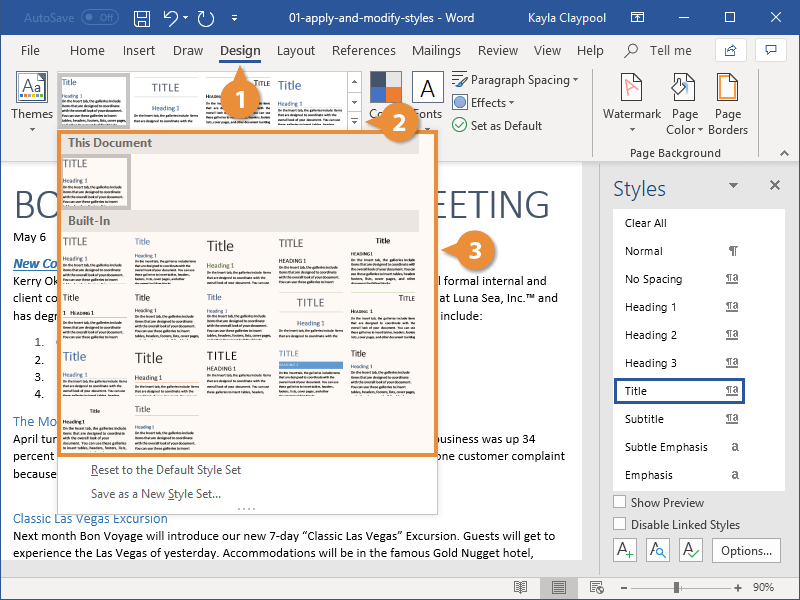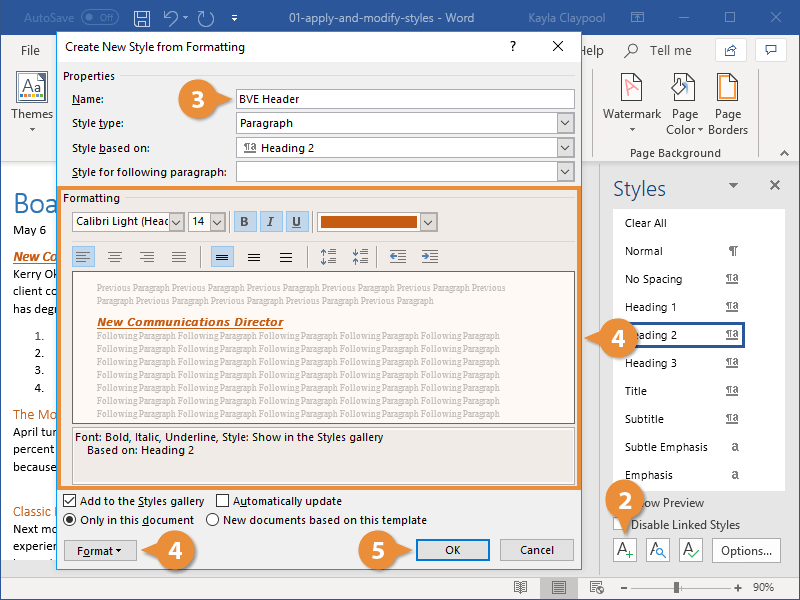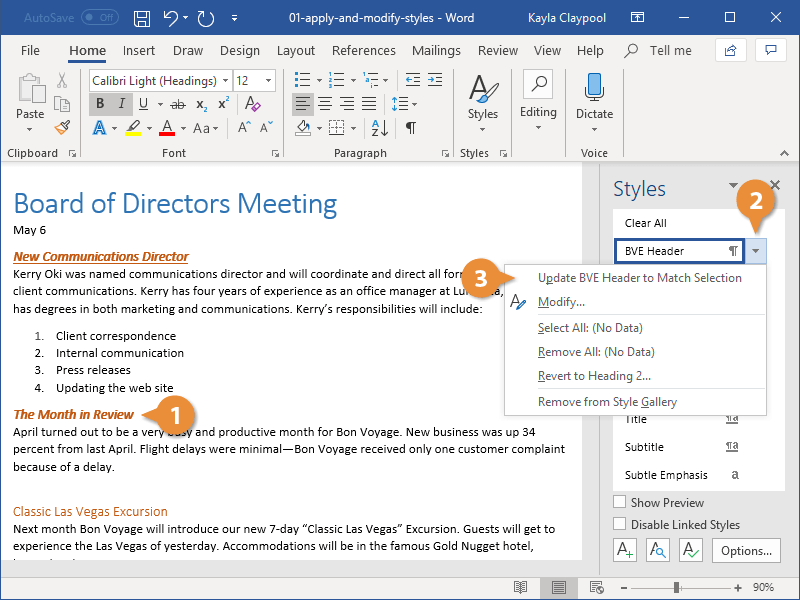Word for Microsoft 365 Outlook for Microsoft 365 Word 2021 Outlook 2021 Word 2019 Outlook 2019 Word 2016 Outlook 2016 Word 2013 Outlook 2013 Word 2010 Word 2007 More…Less
You can use styles to quickly apply a set of formatting choices consistently throughout your document. If you want formatting choices that are not available from the built-in styles and themes available in Word, you can modify an existing style and customize it to suit your needs. You can change the formatting (such as font size, color, and text indentation) in styles applied to titles, headings, paragraphs, lists, and so on. You can also select formatted text in your document to create a new style in the Styles gallery.
The styles covered in this article are located in the Styles gallery, a visual menu located on the Home tab. To apply a style, simply select the text you want to format, and then click the style you want in the Styles gallery. To learn more, see Apply a style to text in Word.

Modify an existing style
You can modify an existing style in the Styles gallery in two ways:
-
Modify a style by updating it to match formatting in your document
-
Modify a style manually in the Modify Style dialog box
Modify a style by updating it to match formatting in your document
If you have text in your document that already has a style applied, you can change the formatting of that text and apply it to the style in the Styles gallery.
-
Select text in your document that has the style applied, such as Heading 1.
When you select text that has a style applied, that style is highlighted in the Styles gallery.
-
Format the selected text with the new attributes that you want.
For example, you might want to change the point size for the Heading 1 style from 16 points to 14 points.
-
On the Home tab, in the Styles group, right-click the style that you want to change, and then click Update [Style Name] to Match Selection.
Note: All text with the style that you changed will automatically change to match the new style that you defined.
Modify a style manually in the Modify Style dialog box
You can modify a style directly in the Styles gallery, without using the text in your document.
-
On the Home tab, right-click any style in the Styles gallery and click Modify.
-
In the Formatting section, make any formatting changes you want, such as font style, size, or color, alignment, line spacing, or indentation.
-
Choose whether the style change applies to the current document or to all future documents.
Create a new style based on document formatting
You can select formatted text in your document to create a new style that you add to the Styles gallery.
-
Right-click the text on which you want to base a new style.
-
In the mini toolbar that appears, click Styles, and then click Create a Style.
-
In the Create New Style from Formatting dialog box, give your style a name and click OK.
Your new style will now appear in the Styles gallery.
Note: If you want your new style to appear in all new Word documents, right-click it in the Styles gallery, click Modify, and then select New documents based on this template at the bottom of the dialog box.
-
Right-click the text on which you want to base a new style, point to Styles, and then click Save Selection as a New Quick Style.
-
In the Create New Style from Formatting dialog box, give your style a name and click OK.
Your new style will now appear in the Styles gallery.
Note: If you want your new style to appear in all new Word documents, right-click it in the Styles gallery, click Modify, and then select New documents based on this template at the bottom of the dialog box.
See also
Apply a style to text in Word
Need more help?
Want more options?
Explore subscription benefits, browse training courses, learn how to secure your device, and more.
Communities help you ask and answer questions, give feedback, and hear from experts with rich knowledge.

(Image credit: Windows Central )
Although you can style every part of a Microsoft Word document individually with unique fonts and colors, it is not a convenient approach since you have to repeat the steps many times, consuming more time and increasing the chances of mistakes, and this is when styles and themes can come in handy.
In the Office apps, styles are collections of fonts, text sizes, and colors that you can apply to different parts of the document (titles, subheadings, quotation, etc.). On the other hand, themes are collections of styles that you can use to format the entire document quickly.
When you use styles and themes, you will still be using a few steps, but it is a more organized way to format a document on Windows 10, and you will really see the benefit when you need to make changes since updating the format can be as easy as selecting a new theme or style.
In this Windows 10 guide, we will walk you through the steps to change the look and feel of Word documents using the style and themes settings whether you use Office from Microsoft 365 or Office 2019.
- How to use styles in Word
- How to use themes in Word
How to use styles in Word
To change the overall look of a Word document, use these steps:
- Open the Word app.
- Under the «New» section, click the Blank document option (or open an existing document).
- Create the document’s content.
- Select with the mouse the text you want to apply a different format – for example, the title.
- In the «Home» tab, under the «Styles» section, select the content type to style.Quick note: When selecting a style, make sure to apply it to the correct formating. For example, if you choose the title, then the style should be «Title.» For the subtitle, select the «Subtitle» style and the rest of the headings using «Heading» 1 through 9 accordingly. And don’t worry about the colors. You will customize these when applying a theme. Also, to view all the available elements, click the More button in Styles’s bottom-right corner.
- Continue applying the styling for subtitles, headings, quotes, and anything else you want to format.Quick tip: You can always click and hold the Ctrl key and use the mouse pointer to select the same parts of the document, including the same stying, for instance, all the subtitles (headings).
Once you complete the steps, the document will be formatted with the styling you selected, and when you make changes to the style, the formatting will change automatically for all the same parts of the document.
In addition to selecting from the predefined settings, you can also create new or modify existing elements to style documents with custom settings.
Create new style element
To create a custom style element in Microsoft Word, use these steps:
- Open the Word app.
- Click the Open option.
- In the «Home» tab, under the «Styles» section, click the More (down-arrow button) menu.
- Click the Create a style option.
- Specify a name for the style.
- Click OK button.
After you complete the steps, the new element will appear in the Styles menu.
Modify style elements
To modify a new or existing style element, use these steps:
- Open the Word app.
- Click the Open option.
- In the «Home» tab, under the «Styles» section, right-click the style and select the Modify Option.
- Customize the style name and formatting settings (for example, font, size, color, aligment, etc.) as necessary.
- Click the OK button.
Once you complete the steps, the new styling changes will apply to the element.
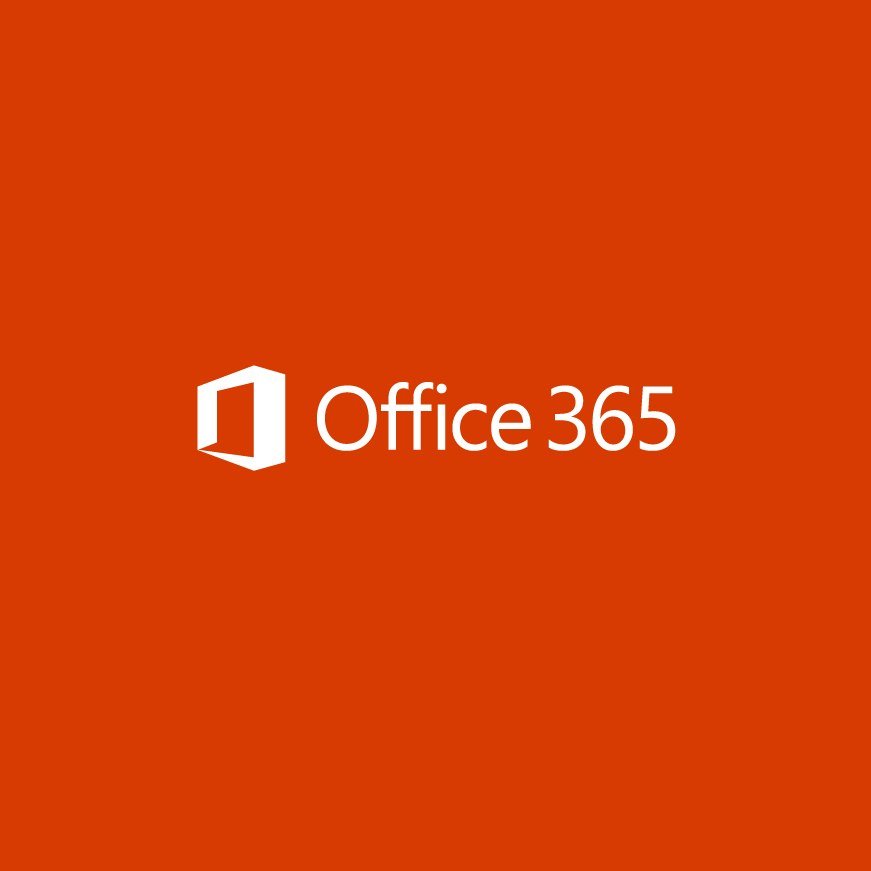
Microsoft 365 gives you full access to all the Office apps and perks, such as 1TB OneDrive storage and Skype minutes. You can also install Word, Excel, PowerPoint, Outlook, and other apps on up to five devices, and depending on the subscription, you can share the account with up to five people.
How to use themes in Word
After applying the style, you can use themes to give the document a different look and feel with colors and a combination of fonts.
To apply a theme to a Microsoft Word document, use these steps:
- Open the Word app.
- Click the Open option.
- Select the document you already styled to open it.
- Click the Design tab.
- Click the Themes button.
- Roll the mouse pointer over the themes to see a live preview of each available theme.
- Click the theme you want for the document.
- (Optional) Use the «Document Formatting» section to select another version of the theme with different combinations of fonts and colors.
- (Optional) Click the «Colors» menu to select a different color scheme.
- (Optional) Click the «Fonts» menu to select a different combination of fonts.Quick note: As you open the menu, the top font is one for the title, the one in the middle is for the subheadings, and the one at the bottom is for the content.
After you complete the steps, the content will incorporate the new colors and fonts available through the theme you selected.
Set theme as the default
To set a theme as the default for Word, use these steps:
- Open the Word app.
- Click the Open option.
- Select the document you already styled to open it.
- Click the Design tab.
- Customize the formatting of the document with colors, fonts, spacing, and effects.
- Click the Set as Default button.
- Click the OK button.
Once you complete the steps, the theme will be available as the default for every new document. However, it won’t apply to the document automatically. Instead, it will be the default theme in the «Style» section, in the «Home» tab.
Create a new theme template
To create a new theme for Microsoft Word documents, use these steps:
- Open the Word app.
- Click the Open option.
- Select the document you already styled to open it.
- Click the Design tab.
- Use the «Document Formatting» section to select a format.
- Click the «Colors» menu to select a color scheme.
- Click the «Fonts» menu to select a combination of fonts.
- Click the «Paragraph Spacing» menu and select one of the predefined options.Quick tip: You can also click the Custom Paragraph Spacing option to create a new style.
- (Optional) Click the «Effects» menu and select the effect you want to use when inserting objects.
- Click the «Themes» menu and choose the Save Current Theme option.
- Confirm a name for the theme.
- Click the Save button.
After you complete the steps, the new theme will be available from the «Themes» menu in the «Custom» section.
More Windows 10 resources
For more helpful articles, coverage, and answers to common questions about Windows 10, visit the following resources:
- Windows 10 on Windows Central – All you need to know
- Windows 10 help, tips, and tricks
- Windows 10 forums on Windows Central
All the latest news, reviews, and guides for Windows and Xbox diehards.
Mauro Huculak is technical writer for WindowsCentral.com. His primary focus is to write comprehensive how-tos to help users get the most out of Windows 10 and its many related technologies. He has an IT background with professional certifications from Microsoft, Cisco, and CompTIA, and he’s a recognized member of the Microsoft MVP community.
Из урока 5 и урока 12 сделан важный вывод: в рабочей области «Стили» должно быть необходимое количество стилей текста. Из моего опыта: около 15 стилей текста. Только тогда будет полноценная работа со стилями. Итак, мы должны понять, что такое «Управление стилями»?
Причины появления лишних стилей рассмотрены на уроке 15. Давайте вспомним причины появления лишних стилей:
- Появление
встроенного стиля при некоторых условиях - Автоматическое
определение нового стиля на базе встроенного - Копирование
текста из других программ - Копирование
текста, который имеет назначенный стиль, из одного документа в другой
От первой причины мы избавились на уроке 17, когда настраивали Word, – нам не грозит появление незапланированных встроенных стилей. Вторая причина работает вне зависимости от нашего желания. Две другие причины мы просто не отрабатывали, то есть не работали с буфером обмена (урок 16).
Скачайте документ тут и откройте его.
Мы аккуратно работали с документом на предыдущих уроках – и тем не менее в рабочей области «Стили» появились стили текста, которые не используются, либо используются от силы один раз:
Я внимательно рассмотрела стили текста в рабочей области «Стили» и создала такую таблицу:
- Перечень стилей в рабочей области «Стили»
- Перечень стилей, которые я использую в своем документе
- Упорядоченный перечень стилей (порядок зависит от степени важности стиля текста, от частоты использования стиля)
| (1) Имеющиеся стили |
(2) Используемые стили |
(3) Конечный список используемых стилей |
|---|---|---|
| Введение | Введение | Введение |
| Заголовок 1 | Заголовок 1 | Заголовок 1 |
| Заголовок 2 | Заголовок 2 | Заголовок 2 |
| Заголовок 3 | Заголовок 3 | Заголовок 3 |
|
Заголовок 4
|
Обычный | |
| Заголовок 5 | Основной | |
| Обычный | Обычный | Список_номер |
| Основной | Основной | Список_6уква |
| Приложение | Приложение | Список_тире |
| Список_6уква | Список_6уква | Приложение |
| Список_номер | Список_номер |
Оглавление 1 |
| Список_тире | Список_тире |
Оглавление 2 |
|
Оглавление 1 |
Оглавление 1 |
|
|
Оглавление 2 |
Оглавление 2 |
|
|
Оглавление 3 |
||
|
Верхний колонтитул |
||
|
Гиперссылка
|
||
| Нижний колонтитул |
Итак, пред нами стоит задача: навести порядок в корзине,
которая называется «Рабочая область «Стили»».
По окончании урока вы
сможете:
- Рассказать,
какие задачи решает закладка «Рекомендации» в диалоговом окне «Управление
стилями» - Скрыть
неиспользуемые стили текста - Определить
порядок появления стилей
1. Закладка «Рекомендации» в
диалоговом окне «Управление стилями»
Шаг 1. Для начала устанавливаем текстовый
курсор на названии документа
Шаг 2. Открываем диалоговое окно «Управление
стилями» (кнопка, которая расположена внизу слева рабочей области «Стили», эта
кнопка называется «Управление стилями»):
Первая кнопка в этом ряду называется «Создать стиль», вторая – «Инспектор стилей». Но кнопка «Управление стилями» включает в себя возможности этих двух кнопок, поэтому первые две копки рассматривать не будем. С этим диалоговым окном мы познакомились на уроке 36, когда делали файла шаблона Normal. На этом уроке мы работали с закладкой «По умолчанию». Но сейчас нас интересует закладка «Рекомендации»:
Я всегда призываю: учитесь читать диалоговые окна – там всё
написано! На мой взгляд диалоговое окно «Управление стилями» очень и очень
информативно. Но дьявол кроется в деталях.
Делаем выводы:
- Число
слева определяет место стиля текста в общем списке стилей (правда нумерация
немного странная – после «2» идет сразу «10», но это на совести разработчиков
программы Word).
Мы можем переместить стиль текста в списке вверх или вниз на одно значение (если выберем стиль текста с номером «2» и нажмём кнопку «Вниз», то этот стиль получит номер «3» и соответствующее расположение). Мы можем сделать стиль текста последним в списке или присвоить конкретное значение.
| Понять и запомнить! |
Порядковый номер стиля текста в общем списке стилей – это ПРИОРИТЕТ! |
Закройте диалоговое окно «Управление «стилями» и подведите курсор к названию стиля в рабочей области «Стили», например, выберите название стиля «Оглавление 1». Вы увидите всплывающие окно с полной характеристикой стиля (урок 4):
Я обвела слово
«Приоритет: 40» рамкой.
| Понять и запомнить! |
В пределах одного номера стили текста сортируются по алфавиту |
Вернёмся к диалоговому
окну «Управление стилями», закладке «Рекомендации».
- В
списке стилей текста присутствуют все стили, которые есть, как встроенные, так
и созданные пользователем. Стили текста имеют три состояния: - видимые (кнопка «Показать»
- скрытые до поры до времени (кнопка «Скрыть до использования»)
- скрытые (кнопка «Скрыть»)
Шрифт названия видимых
стилей имеет черный, а шрифт скрытых
стилей – светло—серый. Вы можете указать на название стиля «Без интервала», которое
имеет чёрную окраску, но тем не менее не присутствует в рабочей области
«Стили». Я отсылаю вас на урок 13, где мы настраивали параметры отображения рабочей
области «Стили»:
Установите режим
«Рекомендованные» в поле «Отображаемые стили» и вы увидите вот такой список рекомендованных
стилей плюс пользовательские стили в рабочей области «Стили»:
Давайте все-таки
зададим режим «В текущем документе» и вернёмся к диалоговому окну «Управление
стилями»:
Теперь, после
знакомства с закладкой «Рекомендации» диалогового окна «Управление стилями»,
приступаем к сортировке нашего списка стилей текста.
2. Сортировка списка стилей текста
Можно теперь вручную
разыскивать стили текста в списке, назначать стилям видимость или невидимость,
назначать порядковый номер в общем списке стилей. Но мы постараемся сделать
проще.
Шаг 1. Выделяем все стили текста (кнопка
«Выделить все»
Шаг 2. Присваиваем всем стилям текста
значение «Последний» (кнопка «Сделать последним)
Шаг 3. Скрываем все стили (кнопка
«Скрыть»):
В результате получаем
такую картину:
Так что же произошло?
Все в порядке. Все стили текста, кроме стилей таблиц, получили 100-тый номер и
благополучно отправились в конец списка стилей. А вот таблицы – это особый стиль,
которому невозможно поменять номер очереди или скрыть с глаз долой. Дело в том,
что список стилей таблиц прячется не в рабочей области «Стили», а совсем в
другом месте. Но о таблицах много позже. А пока примем, как данность, что в
диалоговом окне «Управление стилями» мы найдем абсолютно все стили.
В настоящий момент
стили таблиц нас не интересуют. Поэтому начинаем разбираться со стилями текста
документа.
Напомню, какой список
стилей нам нужен:
| Приоритет |
Порядок используемых стилей |
| 1 | Введение |
| 2 | Заголовок 1 |
| 2 | Заголовок 2 |
| 2 | Заголовок 3 |
| 3 | Обычный |
| 4 | Основной |
| 5 | Список_номер |
| 6 | Список_6уква |
| 7 | Список_тире |
| 8 | Приложение |
| 9 |
Оглавление 1 |
| 9 |
Оглавление 2 |
Шаг 4. Находим название стиля «Введение» (это нетрудно, так в пределах одного номера, в данном случае последнего, названия сортируются по алфавиту:
Шаг 5. Нажимаем кнопку «Показать» и
открываем диалоговое окно «Присвоение значения». В этом диалоговом окне
устанавливаем значение «1»:

Нажимаем ОК, но
остаемся в диалоговом окне «Управление стилями»
Теперь повторяем шаги
4 и 5 для остальных стилей текста, которые будут работать в нашем документе.
Шаг 6. Выделяем при помощи функциональной
клавиши Shift три первых названия стилей «Заголовок …» и в диалоговом окне
«Присвоение значения» устанавливаем значение «2»:
Почему три первых
Заголовка? А больше нам в этом документе не нужно!
Шаг 7. Выделяем стиль «Обычный» и в
диалоговом окне «Присвоение значения» устанавливаем значение «3»:
Шаг 8. Выделяем стиль «Основной» и в
диалоговом окне «Присвоение значения» устанавливаем значение «4»:
Шаг 9. Выделяем стиль «Список_номер» и в
диалоговом окне «Присвоение значения» устанавливаем значение «5»:
Шаг 10. Выделяем стиль «Список_буква» и в
диалоговом окне «Присвоение значения» устанавливаем значение «6»:
Шаг 11. Выделяем стиль «Список_тире» и в
диалоговом окне «Присвоение значения» устанавливаем значение «7»:
Шаг 12. Выделяем стиль «Приложение» и в
диалоговом окне «Присвоение значения» устанавливаем значение «8»:
Шаг 13. Выделяем при помощи функциональной
клавиши Shift два первых названия стилей «Оглавление …» и в диалоговом
окне «Присвоение значения» устанавливаем значение «9»:
Самое время и полюбоваться
результатом:
Всё вместе и всё по порядочку. И никто не сможет нам
диктовать свою волю! Нажимаем ОК и смотрим, что получилось:
Итак, в рабочей области «Стили» всего 12 стилей текста. То
есть необходимое и достаточное количество. Мы даже можем себе позволить
добавить ещё стилей. Например, практически наверняка, нам понадобиться стиль
для названия приложения, который мы назовем «Приложение_Название».
| Понять и запомнить! | Максимальное количество стилей, используемых в документе, должно умещаться на одну страницу рабочей области «Стили». То есть следите за тем, чтобы в рабочей области «Стили» не появлялась полоса прокрутки |
Я сделала два скриншота, чтобы вы увидели, картинку «Было — стало»:
Теперь вы сможете:
- Рассказать,
какие задачи решает закладка «Рекомендации» в диалоговом окне «Управление
стилями» - Скрыть
неиспользуемые стили текста - Определить
порядок появления стилей
Стили в ворде
Просмотров 9.5к. Обновлено 4 сентября 2020
Стиль Word является предопределенным сочетанием шрифтов стиля, цвета и размера , которые могут быть применены к любому тексту в документе. Стили могут помочь вашим документам получить более профессиональный вид. Вы также можете использовать стили, чтобы быстро изменить несколько вещей в документе одновременно.
Содержание
- Как применяются стили в ворде
- Применить набор стилей
- Как создать стиль в ворд
- Изменить существующий стиль
Как применяются стили в ворде
Существующие стили в Word доступны в меню «Стили» на вкладке «Главная». Чтобы применить стиль, просто выделите текст и нажмите на выбранный шаблон. Используемая модель вставляется в рамку с выделенными краями.
Чтобы увидеть больше стилей Word, используйте стрелку в правой части меню «Стили» или откройте меню, нажав на стрелку меню.
Применить набор стилей
Наборы стилей включают комбинацию стилей заголовка и абзаца. Наборы стилей позволяют форматировать все элементы в документе одновременно, а не изменять каждый элемент отдельно.
На вкладке «Дизайн» щелкните стрелку раскрывающегося списка в группе «Форматирование документа».
Выберите нужный набор стилей из выпадающего меню.
Выбранный набор стилей будет применен ко всему документу.
Как создать стиль в ворд
Если вы хотите, применить параметры форматирования, которые недоступны в стилях Word, вы можете без проблем создать их и вставить в галерею стилей:
- Нажмите на меню «Главная» в разделе «Стили» на стрелке в правом нижнем углу.
- Выберите значок «Создать стиль» в «Стилях».
Дайте стилю имя и нажмите изменить.
Определите тип стиля. Вы можете выбрать между «Абзац», «Знак», «Связанный» (абзац и символ), «Таблица» и «Список».
- Если стиль основан на существующем, вы можете установить его в разделе «Стиль на основе».
- Вы также можете выбрать стиль для следующего абзаца в разделе «Стиль для следующего абзаца».
- Определитесь с типом шрифта, размером и другими типами форматирования.
- После подтверждения нажатием «OK» найдите свой новый стиль в меню «Стили».
Изменить существующий стиль
В Word вы также можете изменить уже существующие стили в коллекции стилей.
В группе «Стили» на вкладке «Главная» щелкните правой кнопкой мыши стиль, который хотите изменить, и выберите «Изменить» в раскрывающемся меню.
Появится диалоговое окно. Сделайте необходимые изменения форматирования, такие как стиль шрифта, размер и цвет. Если вы хотите, вы также можете изменить название стиля. Нажмите кнопку ОК, чтобы сохранить изменения.
Когда вы изменяете стиль, вы изменяете каждый экземпляр этого стиля в документе. Если в вашем документе где-то использовался этот стиль и вы поменяли, например, размер шрифта, то он автоматически обновится.
Styles (Word 2007 and later)
Introduction
To use Word properly, one should use Styles. Whilst this can be a bit of a mantra, it is most certainly true: if you don’t
keep your styles under control, you will, sooner or later, be unable to maintain your document as you wish, especially so if
numbering is involved.
To effectively use styles you must understand what is presented to you. You must know what styles are shown where, be able to find
the ones you have used, and those you want, and apply them where you want them.
Unfortunately, Microsoft has chosen to make it almost impossible for all but the experts. There will always be problems with
every feature, and it simply isn’t possible to please everybody all the time, but with styles, and particularly the styles
user interface, Word seems to be striving for a new low. There is no easy way to explain what is a large and significant part of
the product, and I can only apologise up‑front for diving right in and trying to pull the strands together as I go.
After a look at styles, and some of the user interface, I’m going to take a look at the XML that is,
now, the preferred storage mechanism for documents. Why not join me on my adventure?.
A Blank Document and Some Styles
When you start with a blank document in Word, the Styles available for your use are, at least superficially, a combination of
those built into Word and those that exist in your Normal Template.
Your Normal Template is a bit like your DNA, bearing the scars of your personal history: the styles in your
Normal Template bring with them all the changes you’ve made, deliberately or accidentally, over all your years working with
Word. I can’t imagine what you see, so I will start from the beginning. If you start from scratch in Word 2013, this is
something like what you will see at the top right of your screen:
The Built-in Home Tab in Word 2013
There are several points of interest here, the first, perhaps, being how many styles you can see. The image above shows what a user
of a typical modern wide screen is presented with straight out of the box: you may see more or fewer. In my own typical configuration
I see just three: “¶ Normal”, “¶ No Spac…”, and “Heading 1”.
This is what Word thinks important.
You will note that some of the names are truncated and followed by ellipses; this has no special significance; it only means that
the names are too long to fit in the space available. If you hover your mouse over an individual style item, the full name will be
shown in what used to be called a ToolTip.
Words often fail me when describing the Ribbon, partly because information is so hard to discover, but the styles are shown in the
Ribbon in what Word calls the Quick Styles Gallery, or sometimes just the Styles Gallery. At the
right hand edge of the gallery there are three small icons, the bottom one of which looks like an arrow head with a line over it.
If you click on this, the gallery will expand, exactly how depending on your own screen configuration; in this instance it needs
just two lines for all the default styles to show:
The Expanded Quick Styles Gallery in Word 2013
The styles included in the gallery are called Primary Styles. According to the official standard, primary styles
are those designated as particularly important for the current document. The following styles are those that, by default, and on
your behalf, Microsoft has designated as being of particular importance to your empty document:
-
Normal. All content in all Word documents is styled; unless you specify otherwise, it is styled in the Normal
Style. Word treats the Normal Style as its own and it is generally best for users just to accept this and use other styles.The symbol, ¶, that precedes the name is called a pilcrow and is used to signify a paragraph or, in this case, a
Paragraph Style. -
No Spacing. As you can see from the pilcrow, this is another paragraph style but, if you have never seen it
before, the “No Spacing” Style probably makes no sense to you.Prior to Word 2007, the Normal Style used, by default, the Times New Roman (TNR) font.
The TNR font was designed for The Times newspaper and was a serif font, that is all
the letters had little extra marks at the ends of the lines, called serifs. This was to make the letters more distinct and
easier to read when printed on low quality newsprint. TNR has been, and remains, a very popular font
but it is entirely the wrong type of font for use on crystal clear monitors and modern clean white paper.With Word 2007, Microsoft introduced some new sans serif fonts, which did not have serifs
(sans is French for without), designed to be easier to read on the media on which they were used. The Normal
style was changed to use the new Calibri font and, again, to make it easier to read, the spacing between lines, and between
paragraphs, was increased.The No Spacing style was added to Word as a basic style, the same as the Normal style in all respects except
for line and paragraph spacing, which were left as they had been in the Normal style in earlier versions of Word. -
Heading 1 and Heading 2. The Heading styles are meant to be used to structure a document,
and have various characteristics that are beyond this overview. The actual styling applied by default seems to vary by release,
rather suggesting that Microsoft is unsure how best to do it: in Word 2013, Headings are styled in the
Calibri Light font.You will have noticed that these style names are not preceded by a pilcrow and that the styles are not, thus, paragraph styles.
Microsoft calls them Linked Styles. A linked style is actually two styles: a paragraph style and a character
style, the character style having the font characteristics of the linked paragraph style. The distinction is a technical one, to
some extent, but it can lead to misunderstanding and confusion. From what is shown in the Ribbon, you cannot tell the difference
between a character style and a linked style, and care should be taken when using styles with which you are unfamiliar. -
Title and Subtitle. If your document has a title and, perhaps, a subtitle, these are the styles to use. These
are, again, linked styles. -
Subtle Emphasis, Emphasis, Intense Emphasis. Readers with knowledge of web programming may understand the term
“Emphasis”, which is, essentially, web-speak for Italic. Perhaps it makes sense for there to be
consistent terminology but, although Word does understand HTML, it is not, primarily, a web page editor.
Personally I am uncertain whether the qualified Subtle and Intense styles really deserve a
place on the front row, so to speak, but they are examples of how styles can be used.These are Character Styles: they can only hold character formatting, primarily font characteristics. These
particular styles, by default, merely apply italic formatting, and font colour. That, at least, is the impression they try to give;
the reality is, of course, more complex. If you have any knowledge of web programming, and understand the meaning of emphasis in
the context it is used here, you will also know something of cascading style sheets. Word has a similar system
of style inheritance but, in this case, does not use web terminology for it.Styles inherit characteristics from whatever they are based on. The emphasis styles are based on what Word
describes as the Default Paragraph Font. It is important to understand that this means the font as defined
in the style applied to the paragraph of which the text forms a part, not the font applied to the text to which the emphasis
may be applied. If you had, whether using styles or not, applied some formatting to some text (font size, colour, weight, etc.)
and wanted to emphasise part of it, these styles would not be appropriate. They would explicitly format the text in the font
defined in the paragraph and then apply the emphasis over the top of that; they would not apply any emphasis to the text as it
had been formatted. -
Strong. Strong is to Bold, as Emphasis is to
Italic. -
Quote, Intense Quote. Microsoft assumes that these two linked styles are useful enough to
be included in the Ribbon. Perhaps you do, too. -
Subtle Reference, Intense Reference. Two more styles, this time character styles, that
Microsoft seem to think might be useful. -
Book Title. Another character style.
-
List Paragraph. Many, many, documents include lists of one sort or another. At last, perhaps, we have a
paragraph style that might really be useful. A quick look at this style shows it to be indented and no more: no bullets, or
numbers, or anything you might associate with a list.
I have tried to give accurate descriptions of style types as they have appeared, and to describe and explain the styles presented,
but you may think some of my comments, especially the later ones, a bit terse. That is because I find it difficult to believe that
a significant number of Word users will find it helpful to have these styles given such prominence in the user interface. If they
were really useful they wouldn’t suffer arbitrary changes in each new release of the product and my best guess is they are,
in some way, considered exemplary.
The Styles Pane
That’s it, anyway. That’s what you get for your money with Word. You will want to change this, so now it’s time to
look a bit deeper. Underneath the gallery in the Ribbon is the name of the Group within the Ribbon:
Styles. To the right of this, in the far right bottom corner of the group is an arrowhead even more miniscule than
those at the side of the gallery. This one is called the Dialog Launcher; once you know its name it becomes a little
easier to imagine what it might do. This actually launches a Task Pane, rather than a Dialog, but the difference is immaterial for the
moment. Click on it and this Task Pane will appear, by default at the right hand side of your window:
The Default Styles Task Pane in Word 2013
Here, at the moment, with one exception, you can see the same styles you saw in the gallery in the Ribbon. There is one little bit
of extra information: you will remember that Normal, and a couple of other styles in the gallery, were explicitly
shown with a pilcrow to indicate that they were paragraph styles. Here, as well as the pilcrow, you can see a lower case letter
“a”, which indicates a character style, and an underlined pilcrow and letter “a” together, indicating a
linked style. These icons give some hint as to the nature of these styles, and here, though not in the Ribbon, you can tell the
difference between a character style and a linked style.
The one exception is the item, “Clear All”, at the top. You may be able to hazard a guess as to what this does, and you
probably wouldn’t be too far wide of the mark. There used to be a way to remove this, and still is, with VBA,
or by manipulating the underlying XML, but I cannot find how to do so in the user interface. I shall, for the
most part, ignore it for the rest of this discussion.
At the bottom of the pane are three icons, none of which are instantly recognisable. Hover over them each in turn and you will
discover that they are identified as “New Style”, “Style Inspector”, and “Manage Styles”: whether
this knowledge helps you on first sight is questionable, but I hope I will be able to help throw some light on it shortly. Beside
these icons you can see the text: “Options…”; the ellipsis is following a convention that pre‑dates task
panes by many years, though one that may be unfamiliar in this context, and indicates that there is more to see, probably via a
dialog, which should be revealed by clicking it. This is, in a sense, confirmed by noting that the text is underlined when you
hover over it, suggesting that it is probably a hyperlink. As task panes are built with HTML, it is,
technically, a hyperlink, but it doesn’t behave exactly like one as the dialog that is invoked prevents further interaction
with the task pane.
Just before looking at the Options dialog, you will note that there are two options deemed important enough to have pride of place
in the main pane: “Show Preview”, and “Disable Linked Styles”. The Disable Linked Styles
option affects behaviour on the document surface, and will be addressed later: it is hard to see why it has been placed here. The
Show Preview option will change the presentation of the pane as shown below:
The Styles Task Pane in Word 2013, showing Style Previews
Here you see samples of the styles, in much the same way as the swatches are presented in the gallery. This option is, fairly
obviously, relevant here but why it is not presented as part of the options dialog (see below) I have no idea.
Clicking on the Options… hyperlink brings you this:
The Styles Pane Options Dialog in Word 2013
Being recommended is a confusing notion that, in the two places it is used, means two different things. You can not recommend a
style: being ‘recommended’ simply means that a style is not being explicitly hidden (or what is called semi‑hidden,
of which more, later). You can not recommend a sort order, either: styles are assigned priority numbers, and sorting ‘as
recommended’ means no more than sorting in ascending numeric order of priority. The order in which the default styles are
sorted, both in the gallery and in the task pane, is a result of the somewhat arbitrary priorities that Microsoft has assigned
those styles.
Instead of showing recommended styles you can, apart from “All styles” show styles “in use”, or styles
“in current document”. You may, on occasion, be surprised at what Word considers to be in use or, indeed, in the
current document, but, selecting either, on a default system with a blank document will give a short list.
The Styles Pane showing Styles in Use in a blank document in Word 2013
If your document is blank, you might be surprised that the list is not even shorter. How can two styles be in use, or in the
current document, when it is empty or, more accurately, as I’m sure you know, contains but a single terminal paragraph mark?
The paragraph mark does, by default have a style of Normal, but the Heading 1 style is,
in fact, not in use at all.
Word, to an extent, structures documents around headings, and considers them important in various ways, so important that it tells
you, by default, that they are in use when they are not. Word lies because it wants you to be able easily to select
Heading styles, but it has taken a drop of truth serum, and there is a special option that affects their visibility.
If you look back at the Options dialog you will see a checked checkbox with the legend: “Show next heading
when previous level is used”. Heading 1 is there right in front of you, almost demanding your attention.
If you use Heading 1, Heading 2 will then appear in the list, and so on, not quite ad
infinitum, but all the way to Heading 9. If you don’t want this you can uncheck the checkbox and
Heading 1 will no longer be listed.
If you choose to see All Styles, you will get a list of over 100, many of which may make little sense to you. If
you have Show Preview checked you will get a glimpse of how they will appear, but if you have them sorted ‘as
recommended’, the order will appear arbitrary. For the most part, they do have fairly descriptive names, and some of them will
be automatically applied by Word when it thinks them appropriate: Footnote Text, for example, for text in footnotes.
It is unlikely, however, that you will use many of them as provided. There is just one final point worth making, and that is that the
only styles you see here are paragraph styles, character styles, and linked (paragraph and character) styles. There are other types
of style that are presented elsewhere.
I don’t want to dwell too much on every option, and will leave you look at the effect of different sort orders; it is only
really the default ‘as recommended’ that cannot be easily understood, although sorting by font may throw up a surprise
that I may touch on later. Briefly, the other options will not make any difference in the blank document I have been using thus far,
but in a document that has been worked on for any length of time, choosing them can give a good indication of the professionalism
of the author, and can often overwhelm.
Managing Styles
You may remember that the tip, when you hovered over the right hand one of the three icons, was “Manage Styles”. If you
click on this, you get a dialog:
The Edit tab of the Manage Styles Dialog in Word 2013
What is far from obvious here is that the sort order and ‘show recommended styles only’ checkbox are options that relate
only to this dialog, in fact only to the first three tabs of this dialog. The same sort options are available as for the task pane
itself but they affect only the list of styles within the dialog. What is equally far from obvious is that the sort order you choose
is not remembered but whether or not the checkbox is checked is remembered (in the Word Data key in the registry).
The tab that shows first is the Edit tab, about which I have little to say; from here you can, well, edit your
styles. It isn’t really the most intuitive location for the functionality, but it is only two clicks away from the Ribbon,
which might be thought to make it, in the jargon, discoverable.
Some of the styles you see listed may be unknown to you, and some of them will certainly be a surprise if this is your first visit
here. If you have ‘show recommended styles only’ checked, you will see, at the top of the list, the same
‘recommended’ styles as are shown in the Styles Pane. You may be confused by Heading 2,
parenthetically described as “Hide Until Used” but, as noted earlier, Word exhibits some unique behaviour with heading
styles, and its listing here is of no real consequence.
A bigger surprise awaits when you scroll through the list: after the styles shown in the pane, you will see styles called
“Table Grid”, “Table Grid Light”, and over 100 more, all prefixed with a small 2×2 checkerboard symbol:
Table Styles in the Manage Styles Dialog in Word 2013
These are styles of another type: Table Styles. Table styles are not presented in the styles pane, even when you
choose to show “All styles”, and their appearance here as recommended styles just makes the list difficult to navigate.
To look a bit further and see another different type of style, uncheck the ‘show recommended styles only’ box, and scroll
down to these oddly named List Styles:
List Styles in the Manage Styles Dialog in Word 2013
Word wants you to see these and it isn’t going to make it easy to escape.
Recommending Styles
The next tab is the Recommend tab:
The Recommend tab of the Manage Styles Dialog in Word 2013
One nice feature of new dialogs is that they are resizable, and this is indicated by the small patch of grey hatching in the bottom
right hand corner. I have resized this one to show a little more than you see by default and here, at last, you start to get a hint
about how ‘recommending’ works.
Unfortunately, Word does not show you the style types on this tab, but it does have an unexplained number beside each style instead.
If you uncheck show recommended styles only, and scroll to the bottom of the list (assuming you have the list
sorted as recommended) you will see many of the styles say “last” instead of a number. The numbers (“last”
being equivalent to 100) control the recommended sort order; if you look at the list you will see that the styles are in the same
order as those in the Styles Pane.
Below the list of styles is a clutch of buttons. Selecting “All” or “Built‑In” will both have the same
effect until you have created some of your own, non built‑in, styles, and it is difficult to imagine many actions you would
want to do en masse to either selection. You can select as few or as many styles as you wish, using standard
mechanisms, and a little experimentation will soon show you the effect on the selection of the four buttons in the ‘set
priority’ section.
What may not be immediately obvious is that, if you select one of table styles or list styles, all the buttons will be greyed out
indicating that you can’t actually do anything with these. If you select one of these styles along with one, or more, of the
paragraph or character styles, the buttons will not be greyed out but they will not have any effect on the table or list styles.
The table and list styles really do just get in the way of doing what you want to do.
The buttons to select whether or not styles show as recommended styles, have legends that reflect the settings that can be applied
and you may recognise “Hide until used” as parenthetical text that appears after many style names in the list.
Hide Until Used is a useful setting that stops you getting drowned in a sea of styles you neither need nor want
to see. Hide, on the other hand, seems rather pointless: there can be very few circumstances where you really want
to hide a style you are using. To see the effect of hiding a style, however, choose, and select, a style you are using and click
on “Hide”; the style name will turn (or remain) grey and “(Always Hidden)” will appear after its name in
the list. The style will then stop appearing in the Styles Pane and the Styles Gallery.
Restricting Styles
I’ve tried to go through the presentation of basic styles in the Ribbon, and in the Styles Pane, and give you some idea of
what you see and why, which is really all I want to look at, at the moment. For some sort of completion, however, I will take a brief
look at the other tabs in the dialog. On the next, tab, “Restrict”, we find this:
The Restrict tab of the Manage Styles Dialog in Word 2013
Here you, again, see your list of styles. Below the list are some buttons for some generic selections; you are still able, of course,
to make your own selections but it isn’t easy from the long list. Having made your selection you can permit,
or restrict, the styles. By default, styles are permitted, and if you restrict one a little padlock will appear
beside its name, but that is all! On this tab you can restrict any, or all, styles, including the table styles and list styles even
though, thus far, you know nothing about them.
Below the buttons there is a checkbox labeled “Limit formatting to permitted styles”. For your restricting to have any
effect you must check this. When you do so you will see that the “Allow AutoFormat to override formatting” becomes enabled.
This gives you a hint about the complexities to come: styles can be applied by other features of Word and it is clearly going to take
a lifetime to master this feature! Look at the checkboxes below and you see “Block Theme or Scheme switching” and
“Block switching to a different style set”. Themes? Schemes?
Style Sets? What are these? I’m sorry to say that I’m not going to tell you, not yet anyway; these
complications are far beyond the scope of this overview.
What I am going to tell you, just because it is so ridiculous, is a little bit more about restriction. Invoke the
Manage Styles dialog, select the Restrict tab, select a style – say No Spacing
– and click “Restrict”; as noted above, a little padlock will appear beside the style name. Now check the “Limit
Formatting” checkbox and click “OK”. You will be shown this dialog:
Start Enforcing Protection in Word 2013
Here you can set a password so that, you might think, the styles you have restricted cannot be used without entering the password.
Word does warn you that ‘malicious’ users can remove the password, and I’m sure I have said before that this is
child’s play. This superficial kind of protection, however, can serve a purpose in tending to stop users accidentally undoing
all your good work. Enter a password (twice) and press OK.
You can easily check to ensure that your restrictions are protected. One way is to return to the Restrict tab in
the Manage Styles dialog, uncheck the Limit Formatting checkbox, and click “OK”.
This time you will be shown this dialog:
Password Input to Unprotect a Document in Word 2013
In order to remove the protection, you must enter the password; this is entirely in keeping with what one would expect, but ‑
Cancel the unprotect dialog and return to the Manage Styles dialog while your restrictions are
still in effect. Here you can permit the style you previously restricted and, if you wish, restrict some others;
in other words you can completely change the restrictions without ever being asked for the password. I did not know this, I stumbled
across it entirely by accident as I was preparing this article but it seems to be the case in Word 2007, Word 2010, and Word 2013.
Put another way, this feature has, presumably, never been used. I can only speculate as to the reasons for this, but it seems somehow
representative of the Styles user interface, as it currently exists.
Setting Defaults, and More
The final tab is the “Set Defaults” tab:
The Set Defaults tab of the Manage Styles Dialog in Word 2013
Document defaults are not a style; you cannot format text or paragraphs as document default;
document defaults are, however, what all paragraph and character styles are based on. The user interface, as you can see above, gives
a very limited set of attributes but, as far as I know, all paragraph and character attributes can be set as document defaults, if
you know how to do it (which I may describe later).
Just before moving on, a brief word about the options at the bottom of the dialog. Most of the time you will want the changes you
make to affect only the document you are working on but there may be situations where you want changes made in the template; all I
will say is: be careful!
Finally, the “Import/Export” button takes you to the old Organizer Dialog, now with just two tabs: the Styles tab, of
which more in due course, and the Macro Project Items tab, which has nothing at all to do with styles. The jump to this separate
dialog is one way: you cannot come back.
The Story So Far: A Quick Summary
I like to think that readers of my ramblings know, at least, the basics, and I have not shown you how to use styles at all. I have
told you a little about the styles that come with Word, and the way in which Word presents them to you, and I have gone in to some
detail about what Word calls Managing Styles. I had intended to show you what happened when I asked for help by
clicking the question mark icon in the top right hand corner, but that bit of uselessness will have to wait for another time and
another article. There is much more to come, but now I want to take a look behind the scenes to try to understand what should
happen, what is happening, and what might happen when documents are changed in ways that cannot be achieved through Word. The next
page, to be found herehere [link to the next page in the series at LatentStyles.php] is about what the standard calls
Latent Styles.

A style is a group of formatting settings stored under a single name. Using styles and style sets rather than formatting ad hoc has several advantages:
- The document looks professional and is easy to read.
- Styles provide consistency and can apply several formatting properties at one time.
- Heading styles can be used to create tables of contents and outlines.
- If you change the formatting properties of a style, all instances of the style are updated with the formatting changes.
Apply a Style
Word includes several built-in styles that cover most basic formatting needs in a document.
- Click in the paragraph or select the text you want to apply a style to.
- Click the Styles group dialog box launcher on the Home tab.
- Select a style from the Styles pane.
Alternatively, you can browse within the Styles gallery on the ribbon, which will also preview the formatting used in the style, but it’s often easier to choose from all the available styles at once by clicking the dialog box launcher.
The style is applied to the text or paragraph.
Change Style Sets
Another advantage to using styles throughout your document is the ability to quickly change how those styles appear using Style Sets.
Style Sets will update the appearance of the built-in default styles. This way, you can format these elements at once instead of one by one.
- Click the Design tab.
- Open the Style Set gallery by clicking the gallery’s More button.
- Select a Style Set.
Thumbnails previewing the available Style Sets appear.
The new Style Set is applied, affecting all the default styles used in the document.
| Default Styles | |
|---|---|
| Normal | The document’s main body text. Any text not using another style is set in Normal. |
| No Spacing | Normal text, with no additional spacing between paragraphs. |
| Heading 1, 2, 3 | Three levels of headings to use in your document, with outline levels automatically applied. |
| Title | A larger heading, useful for the main title of a document. |
| Subtitle, Subtitle Emphasis | Subtitle text, styled to complement the Title style, along with an additional style for emphasis. |
| Emphasis, Intense Emphasis, Strong | These styles are meant to emphasize text in a document. Emphasis usually italicizes, Strong usually bolds, and Intense Emphasis will usually do both. |
| Quote, Intense Quote | These styles will separate blocks of text to display a quote. |
| Subtle Reference, Intense Reference, Book Title | These styles are meant for text used to cite references and book titles. |
| List Paragraph | This style is automatically applied when text is used in a numbered or bulleted list. |
Create a Style
You can also create your own styles, saving a set of formatting to use easily in other places. If the need arises, creating a style is quick and easy. There are five different types of styles:
- Character: Includes any type of character formatting, such as font size, type, color, and effects. These styles can be applied to any selected text.
- Paragraph: Includes any type of paragraph formatting, such as paragraph, tab, border, and bullets and numbering formats. These styles will be applied to entire paragraphs.
- Linked: Uses a combination of character and paragraph formatting properties. These styles will be applied to entire paragraphs as well.
- Table: Provides a consistent style for all borders, shading, alignment and fonts in tables.
- List: Applies similar alignment, numbering or bullet characters and fonts to lists.
You can also base a style on another style. The new style will inherit the formatting of the original style, as well as any changes made to the original style later.
- Format the selected text the way you’d like it to appear in your style.
- Click the New Style button, in the Styles pane.
- Give the new style a name.
- Make any additional adjustments to the style formatting.
- Click OK.
The differences between the selected text that was formatted and the style that it’s based on will be captured. The style that it’s based on will also be listed here.
Basic formatting commands are found right in this dialog box. To customize more advanced formatting, click the Format button and select a category from the menu.
The new style is created and can be applied to other text in the document.
Modify a Style
One of the benefits of using styles is that when you make a change to one, everything that’s using the style is automatically updated.
- Change the formatting of some text using a style.
- Click that Style’s list arrow in the Styles pane.
- Select Update [style name] to Match Selection.
To delete a style, select Delete or Revert to [style name]. If there is no option to delete the style, reverting it back to the style it was based on effectively deletes the style.
The style is updated, and the changes you made are applied to all text that uses the style.
Only Show Styles in Use
There are a lot of built-in styles that don’t get used and get in the way of the styles you’re working with. You can change the Styles pane settings to show only the styles used in a document.
- Click Options in the Styles pane.
- Click the Select styles to show list arrow.
- Select In use.
- Click OK.
The Style Pane Options dialog box opens.
Now only the styles used in the document are shown in the Styles pane.
FREE Quick Reference
Click to Download
Free to distribute with our compliments; we hope you will consider our paid training.
Word styles present a bit of a conundrum for users. They’re powerful but a bit mysterious, so users tend to avoid them. The truth is, if you’re using Word for anything, you’re implementing styles, whether you realize it or not. So, it makes good sense to expand on that foundation. Once you master styles, you’ll love them (or not, but you’ll definitely take advantage of them!) In this article, I’ll show you five easy ways to control styles, so you can put them to good use.
I’m using Word 2016 (desktop) on a Windows 10 64-bit system. Styles have always been around, and although you can implement them in older versions, the step-by-step instructions will differ. There’s no demonstration file; you won’t need one. The browser edition supports existing styles. You can change styles, but you can’t create custom styles in the browser.
1. Start over
Despite the best of intentions, a document can become overwhelmed by direct formatting and modified styles. This is especially true when a document has gone through several different users, each making the document their own by modifying styles and adding direct formatting.
Formats comes in two levels: direct and styles. Direct formatting is a manually applied format, such as clicking the Bold or Italics button. You apply numerous attributes at once using a style. It’s important to understand the differences between the two when removing them.
You can remove direct formatting by selecting only that content and pressing Ctrl+Space or choosing Clear All Formatting in the Font group. If the content has an applied style (other than Normal), neither route will remove the style. If you select an entire paragraph or the entire document, both Ctrl+Space and Clear All Formatting will remove all direct formatting and remove all formatting leaving only plain text.
SEE: 20 quick Windows tips for power users (free PDF) (TechRepublic)
2. Modify the built-in styles
Styles may streamline formatting tasks, but the built-in styles won’t always be adequate. It’s easy enough to create a custom style, but that presents a problem–many Word features, such as the table of contents, depend on the built-in styles. For example, if you assign a custom style to headings, you’ll have to work extra hard to get Word to recognize those headings when generating a table of content.
Fortunately, you can modify built-ins in one of two ways. First, the long way:
- Click the Home tab, right-click the style you want to modify in the Style Gallery, and then choose Modify.
- In the Modify Style dialog, change style attributes. For instance, in Figure A, I changed Heading 1’s font size (I made it smaller; it was 16). You’ll find more formatting options by clicking the Format button in the bottom-left corner.
- After making all the changes you want to the style, click the New documents based on this template option (at the bottom) if you want all new documents to share this modified built-in style. If, on the other hand, the changes are meant for only the current document, retain the default option of Only in this document.
- Click OK.
Figure A
Change a built-in style’s attributes.
Using Undo immediately (or pressing Ctrl+z) works when modifying styles. In addition, instances of the styled content will update immediately in the current document.
A quicker way to modify a style is to apply the formatting to content in a document. Then, select the newly formatted content, right-click the (selected) style in the Style Gallery, and choose Update style to Match Selection from the dropdown list, as shown in Figure B. As before, the update is immediate in the existing document. However, this route doesn’t modify the underlying template.
Figure B
Use selected content to modify an existing style.
3. Create a custom style
If Word feature integration isn’t a consideration, you can quickly create custom styles from formatted content. It works with character and paragraph styles. Simply format the text or paragraph. Then select it, and do the following:
- Click the Home tab.
- Click the Style Gallery’s More button (circled in Figure C) and choose Create a Style.
- Enter a name for the new style (Figure C).
- Click OK.
Figure C
Create a custom style.
4. Use styles in other documents
You won’t have to modify an existing style or create a custom style if it already exists in another document. You can copy it from the other document using the Organizer. To launch the Organizer, click the More button in the Styles Gallery to open the Styles pane. Then, click Manage Styles (the third button in the row at the bottom). In the resulting dialog, click Import/Export. It’s buried deep. If the Developer tab is visible, click Document Templates in the Templates group and click Organizer in the bottom-left corner. There’s a shortcut, but it’s not intuitive: Alt+l+u+o.
On the Styles tab, you’ll see two list of styles, as shown in Figure D. Either side can display styles from the current document or the underlying template, so be careful. If the style you’re looking for isn’t available, click Close File and then open the document that contains the styles you want to copy.
Figure D
Use the Organizer to add styles from other documents and templates.
When you find the style you want to copy, select it, and click Copy. It makes no difference whether you’re copying from the open document to the template or vice versa. That’s where some users lose their way. This feature is flexible enough to handle either request.
If the destination file contains a style with the same name, Word will warn you. You can replace the existing style, or you can rename the style you are copying and retain both in the destination file.
It’s important to note that both lists display only the styles currently in use. Many styles aren’t used. You can delete a style, but the next time you open the document, it will be back; this action isn’t permanent.
SEE: 10 all-purpose keyboard shortcuts to boost your Word efficiency (free PDF) (TechRepublic)
5. Quick style overview
For a quick view of the styles in use, click the View menu and choose Outline or Draft in the Views group. Doing so will display the paragraph styles in use to the left, as show in Figure E. If you don’t see that pane, do the following to display it:
- Click the File tab and choose Options from the left pane.
- Select Advanced in the left pane.
- In the Display Options section, find the Style area pane with in both Draft and Outline views option and enter a value such as 1 or 1.5.
Figure E
Display styles in use to the left of the document.
Send me your question about Office
I answer readers’ questions when I can, but there’s no guarantee. Don’t send files unless requested; initial requests for help that arrive with attached files will be deleted unread. You can send screenshots of your data to help clarify your question. When contacting me, be as specific as possible. For example, “Please troubleshoot my workbook and fix what’s wrong” probably won’t get a response, but “Can you tell me why this formula isn’t returning the expected results?” might. Please mention the app and version that you’re using. I’m not reimbursed by TechRepublic for my time or expertise when helping readers, nor do I ask for a fee from readers I help. You can contact me at susansalesharkins@gmail.com.


